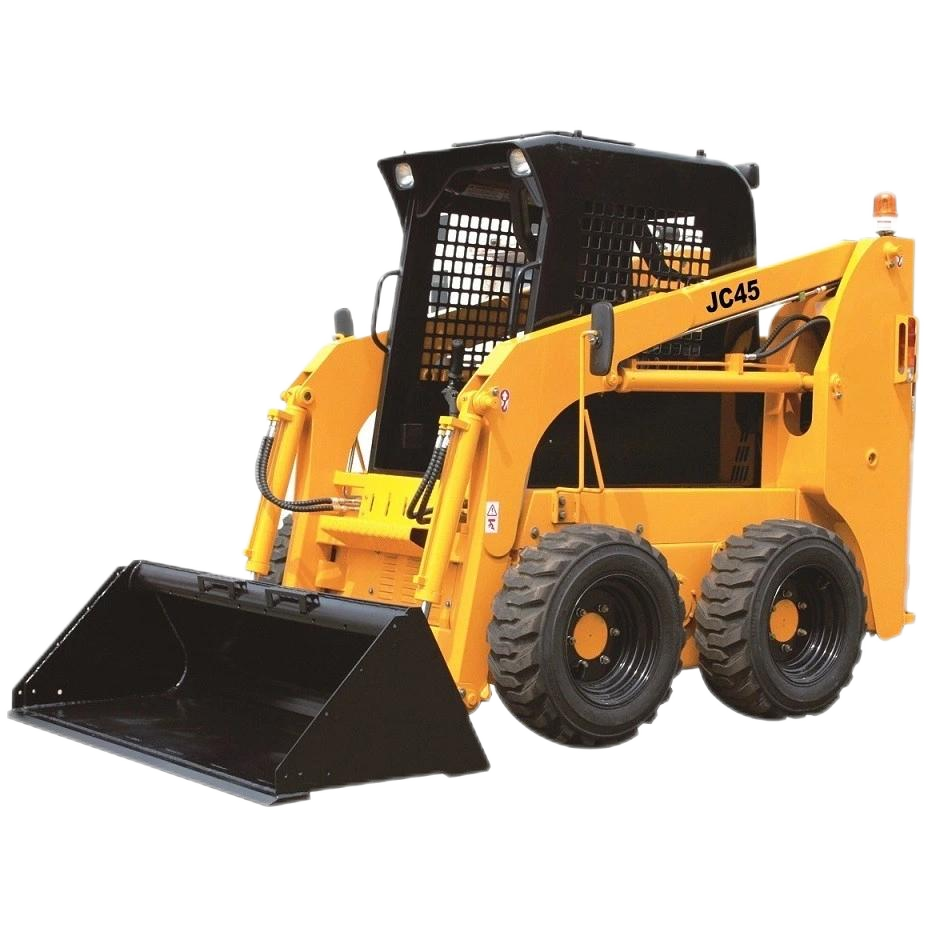A skid steer loader is a small-sized multi-functional construction machine, whose core value lies in "efficient utilization of narrow spaces" and "flexible adaptation to multi-functional scenarios". It shows irreplaceability especially in scenarios that are difficult to be covered by traditional large-scale equipment. The following is a detailed analysis from three dimensions: core value, application scenarios, and economic benefits:

Skid steer loaders are small in size (3-4 meters in length, 1.5-2 meters in width, and 2-2.5 meters in height) and adopt "skid steering" (steering through the speed difference of tracks/tires on both sides without additional steering space). Their minimum turning radius is close to 0, enabling them to easily pass through narrow passages (such as basements, roadways, workshop aisles, and community corridors) and even complete 360° rotation on the spot.
This feature makes it the "only choice for operations in narrow spaces" — for example, in indoor warehouse cargo handling, basement earthwork cleaning, mine roadway repair, and garbage removal during indoor decoration of shopping malls, traditional wheel loaders or excavators cannot enter due to their large size, while skid steer loaders can operate efficiently.
The quick-change attachment system of skid steer loaders (which can replace attachments in 1-2 minutes) allows them to be equipped with dozens of working devices, covering all scenarios from "handling, crushing, cleaning" to "excavating, loading, and high-altitude operations":
- Basic attachments: buckets (for loading and unloading materials), bulldozer blades (for leveling), forklift attachments (for stacking);
- Special attachments: hydraulic breakers (for breaking concrete), sweepers (for road cleaning), augers (for digging holes), aerial work platforms (for maintenance), snow blowers (for municipal snow removal), etc.
This ability of "quickly switching functions" enables it to complete multiple tasks at the same job site (such as first shoveling garbage and then cleaning the ground with a sweeper), greatly reducing the idle time of the equipment.
Although skid steer loaders are small in tonnage (mostly 1-3 tons), their efficiency in light-load scenarios is far higher than that of manual labor or small tools:
For example, in municipal engineering such as sidewalk renovation (transporting a small amount of sand and gravel), farm feed distribution (short-distance transportation), and logistics warehouse loading and unloading (palletized goods), their operating efficiency is 5-10 times that of manual labor, and the cost is lower than the calling cost of large equipment (such as wheel loaders).
- Urban community renovation: transporting construction waste and laying floor tiles in narrow areas such as corridors and green belts;
- Underground engineering: earthwork cleaning in subway tunnels and basements (when the height is less than 3 meters, excavators cannot enter);
- Municipal maintenance: sidewalk breaking, manhole cover surrounding repair, and snow removal on community roads in winter (without damaging the road surface).
- Indoor warehouses: loading and unloading palletized goods in narrow channels (width less than 2 meters) between shelves (equipped with forklift attachments);
- Ports/stations: cleaning up scattered goods inside or around containers (traditional forklifts have insufficient turning radius).
- Farms: transporting fertilizers and cleaning manure in greenhouses (equipped with buckets or sweepers);
- Pastures: feed mixing and silage transportation (without the need for large equipment to enter the pasture).
- Post-disaster rescue: cleaning obstacles in narrow spaces of ruins after earthquakes and floods;
- Chemical workshops: handling materials in explosion-proof areas (equipped with explosion-proof attachments) to avoid manual contact with dangerous environments.
- Purchase cost: The price of 1-3 ton skid steer loaders is about 150,000-400,000 yuan, which is much lower than that of 5-ton wheel loaders (300,000-800,000 yuan);
- Operating cost: Low fuel consumption (5-10 liters per hour, while wheel loaders consume 15-25 liters per hour), simple maintenance, suitable for small and medium-sized enterprises or individual users.
In narrow sites, the operating efficiency of skid steer loaders is 5-10 times that of manual labor, and they can complete tasks that cannot be covered by large equipment (such as indoor operations), avoiding construction delays caused by equipment being "unable to enter".
A skid steer loader equipped with multiple attachments can replace multiple devices such as "small excavators, forklifts, and sweepers". It is especially suitable for users with changing operation scenarios (such as municipal engineering teams and small construction enterprises), reducing the number of equipment purchases.
Its core value is not to "replace large equipment", but to "fill the scenario gaps that cannot be covered by large equipment" — in narrow spaces, multi-functional needs, and light-load fine operations, skid steer loaders are the most efficient and cost-optimal choice. For users who need to take into account "flexibility, multi-functionality, and small-space operations" (such as municipal administration, warehousing, and small engineering teams), its value far exceeds the price of the equipment itself; while for pure heavy-load and open-site operations, it cannot replace wheel loaders.






